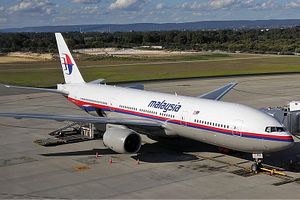As authorities and analysts around the world begin to piece together the events surrounding the downing of Malaysian Airlines Flight 17 over eastern Ukraine, many people are revisiting a similar event that occurred 31 years ago. The 1983 shoot down of Korean Airlines Flight 007 near Sakhalin Island claimed the lives of 269 people, including that of U.S. congressman Lawrence McDonald, and stood out as one of the lowest points in U.S.-Soviet relations in the last decade of the Cold War. Briefly comparing and contrasting these two tragic catastrophes provides insights into how this most recent crisis may unfold in the coming weeks and months.
After refueling in Anchorage, Korean Airlines Flight 007 was attacked by a Soviet Sukhoi Su-15 fighter after it unintentionally strayed into Soviet airspace on its way to Seoul. Much like the current situation in Ukraine, the downing of this civilian airliner was preceded by worsening relations between Moscow and Washington. In particular, increasing paranoia in Moscow over its intelligence vulnerabilities and the naval exercises by the U.S. Pacific Fleet in April 1983 further heightened anxieties that had been building since the Soviet invasion of Afghanistan and the deployment of Pershing II missiles to West Germany in 1979.
After the Korean airliner was downed on September 1, 1983, the Soviet Union first refused to acknowledge the shoot down and then later confessed to the attack but insisted that the incident was a “sophisticated provocation, organized by the U.S. special services and using a South Korean airplane.” Meanwhile, the cockpit voice recorder from the flight was recovered in October of 1983, but was kept secret by Soviet authorities and would not be handed over to Seoul until 1992. It showed that the South Korean pilots were likely unaware of their location when the plane was shot down.
There are several superficial similarities between the 1983 case and the most recent incident involving the Malaysian Airlines flight, but the contrasts are much starker. There had been a high level of tension between the U.S. and Russia prior to the shoot down of Flight 17, but nowhere near as tense as bilateral relations during the early Reagan years. At the same time, the 1983 incident did not occur over an active combat zone such as eastern Ukraine.
In addition, the complexity of the situation on the ground in eastern Ukraine obscures who is responsible. In an interview with the Wall Street Journal, Lieutenant Colonel Scott Mann of the Stability Institute noted that the sophisticated surface-to-air missiles that shot down the Malaysian Airlines flight could have only been operated by someone with at least five to six months of training, strongly suggesting Russian assistance. Nonetheless, as Zachary Keck points out, direct involvement by Russian personnel will be difficult to pin down.
As a result of these differences, the downing of the Malaysian Airlines flight cannot be resolved in the relatively cool and measured way that the incident in 1983 was settled.
Lawrence J. Goodrich, a former U.S. Foreign Service officer, wrote an insightful article in September 1988 highlighting some of the lessons from 1983. In particular, he pointed out how the Reagan administration’s response was aimed at Moscow taking corrective actions without attempting to forward a more broad-based punishment targeting other ongoing conflicts like the Soviet intervention in Afghanistan. The end result was the 1985 U.S.-Japan-Soviet North Pacific Air Safety Agreement, which established communication links between the Anchorage, Tokyo, and Vladivostok air traffic control centers so that commercial airliners straying into restricted airspace could be more easily identified and redirected. This also set the stage for the resumption of U.S.-Soviet commercial flights in 1986 and the further thawing of relations.
Unfortunately, the situation surrounding Malaysian Airlines Flight 17 will not follow the same course. Since the attack occurred over a conflict zone, which has already prompted U.S. sanctions against Russia, any move taken by Washington will most likely further aggravate tensions in the region. There is also no one that Washington can properly negotiate with since the responsible parties are difficult to pinpoint and an uninhibited investigation into what had happened will be next to impossible inside the rebel-occupied zones.
Therefore, while American media outlets are already underscoring the importance of emulating Washington’s prudence in 1983, the Obama administration faces very different constraints in eastern Ukraine that will most likely lead to more turbulence in U.S.-Russia relations.

































